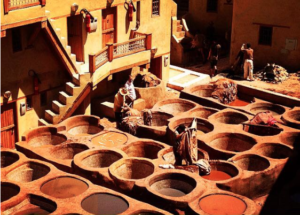Fez: The Blind City
 As our group was strolling down one of the narrow, cobbled alleys of the medina of Fez, I was more preoccupied with the busy atmosphere of the street than with the monotonous discourse of our English-speaking guide. I only emerged from my torpor after our band halted in front of an unpretentious white house with a plain wooden door. Our guide slowly opened the cracking door, revealing a vast and richly decorated courtyard, and muttered: “In Fez, everything is hidden; the Blind city is full of surprises.”
As our group was strolling down one of the narrow, cobbled alleys of the medina of Fez, I was more preoccupied with the busy atmosphere of the street than with the monotonous discourse of our English-speaking guide. I only emerged from my torpor after our band halted in front of an unpretentious white house with a plain wooden door. Our guide slowly opened the cracking door, revealing a vast and richly decorated courtyard, and muttered: “In Fez, everything is hidden; the Blind city is full of surprises.”
Indeed, behind this simple door laid one of the jewels of the medina: the Medersa Bou Inania. Built in 1350 by the Merinides dynasty, it is famous for being one of the most well-preserved and spectacular medersas in Morocco. The luminous and wide courtyard is blinding to the unprepared visitor’s eyes and contrasts with the obscure and narrow medina. The Medersa was a place of education and teaching. Its walls reflect the past grandeur of the imperial city of Fez: multicolored and geometrical patterns of zellij complement the finesse of calligraphic motifs in Arabic, which is surmounted by detailed white stuccos.
This constant paradox between the outside and the inside is the foundation of the myth of Fez and infiltrates every corner of the city. Famed American author, Paul Bowles, asserted that this disease had reached the very soul of its inhabitants as “the Fassi feels intuitively that everything should be hidden: the practice of his religion, his personal possessions (including his womenfolk), and above all his thoughts.”
For all their attempt to remain out of the spotlight, the Fassis have dominated the Moroccan political and economic landscape for centuries. The importance of the city’s nobility in modern Morocco is best exemplified by the El-Fassi family, which includes the founder of the monarchist and conservative Istiqlal party, Allal El-Fassi, as well as Abbas El-Fassi, a former Prime Minister, and Taieb Fassi-Fihri, Morocco’s former Foreign Minister and current personal advisor to His Majesty King Mohammed VI. The El-Fassi family, through their prestigious offices, has relentlessly promoted the nationalist platform of a “Greater Morocco” and advocated the return of the lands historically associated with the Sultanate of Morocco, notably in the Western Sahara (see here and here).
Nevertheless, some Moroccans have decided to contest the legacy of the powerful El-Fassi family. Indeed, the movement of social contestation that followed the beginning of the Arab Spring in Tunisia in the form of the 20 February Movement (M20F) led to the overwhelming victory of the islamic Justice and Development party (PJD) over Istiqlal and ushered in a wave of constitutional reforms. In Fez itself, the mayor and Secretary General of the Istiqlal party, Abdelhamid Chabat, was replaced in 2015 by a PJD candidate.
Yet, these changes might not be sufficient for conservative and introverted Fez, and the rest of Morocco, to become the full-fledged democracy the international community had hoped for. The revised constitution gave the government more power over policy and appointments, but the King remains firmly in charge. Moreover, many are limited or radical in their critique of the establishment: a third of Moroccans are illiterate, while around 1,500 have joined the Islamic State (IS) in Iraq, Syria and Libya, and could return to launch attacks against the country and its government.
Fez, because of its large population - it is the third biggest city in Morocco - and its eroding tradition of religious and political conservatism, may play an important role in the future of Morocco if it chooses to keep its eyes wide open.

